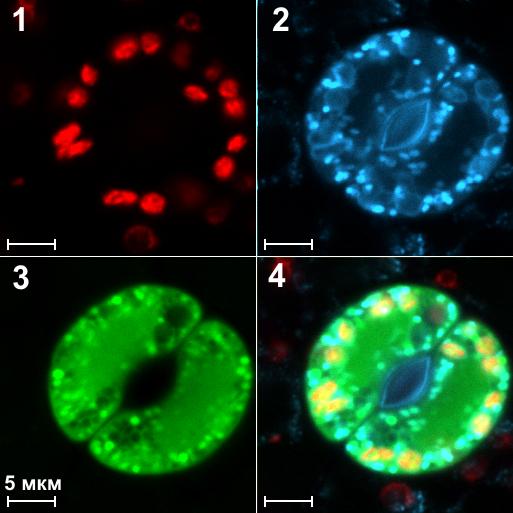Antioxidants developed by MSU scientists slow down senescence in plants

1 - Chloroplasts (fluorescence of chlorophyll), 2 - mitochondria stained with rhodamine dye, 3 - ROS (fluorescence of 2',7'-dichlorofluorescein), 4 - joint image of chloroplasts, mitochondria and ROS. Credit: Courtesy of Dmitry Kiselevsky
ROS are frequently formed in mitochondria – the power factories of the cells. Mitochondria-targeted antioxidants, including SkQ ions, affect mitochondria directly and prevent the synthesis of dangerous molecules.
Their action mechanism is not completely clear yet, but scientists believe it consists of two parts. The first one is a chemical reaction of SkQ with ROS or their products. The second is implemented due to the reduction of transmembrane difference of electric potentials in mitochondria which suppresses the formation of mitochondrial ROS.
A team from the department of immunology (Faculty of Biology, MSU) tested the effect of SkQ mitochondria-targeted antioxidants on plant cells. The main target of the study was to find out the influence of these substances on chloroplasts in which photosynthesis takes place.
The scientists demonstrated that in nanomolar concentrations SkQ suppressed the death of plant cells caused by the influence of poisons in pea leaves. In micromolar concentrations the antioxidants slowed down photosynthesis in chloroplasts and stimulated respiration in mitochondria.
The team also found out that SkQ antioxidants slowed down the senescence and death in the leaves of Arabidopsis thaliana, a plant from the Cruciferae family.
“An important moment for us was that these antioxidants contain plastoquinone from plants, namely from chloroplasts that capture and convert the energy of light into a form that is accessible to plants. Therefore we needed to study how these compounds would influence plant cells and interact with chloroplasts,” – explained Dmitry Kiselevsky, a co-author of the study and a senior researcher of the Faculty of Biology, MSU.
The scientists also concluded that mitochondria-targeted antioxidants in low concentrations do not influence cell respiration and photosynthesis in chloroplasts. The antioxidants in question may be used in biotechnologies and agriculture in certain concentrations that do not affect these processes.
“The research of mitochondria-targeted antioxidants studies the role of mitochondria in the formation of ROS, as well as the programmed plant cell death. Currently our lab is working on the role of another energy exchange system (glycolysis) in the formation of ROS in plants,” – added Dmitry Kiselevsky.
Media Contact
More Information:
http://dx.doi.org/10.1016/j.mito.2018.04.008All latest news from the category: Life Sciences and Chemistry
Articles and reports from the Life Sciences and chemistry area deal with applied and basic research into modern biology, chemistry and human medicine.
Valuable information can be found on a range of life sciences fields including bacteriology, biochemistry, bionics, bioinformatics, biophysics, biotechnology, genetics, geobotany, human biology, marine biology, microbiology, molecular biology, cellular biology, zoology, bioinorganic chemistry, microchemistry and environmental chemistry.
Newest articles

A universal framework for spatial biology
SpatialData is a freely accessible tool to unify and integrate data from different omics technologies accounting for spatial information, which can provide holistic insights into health and disease. Biological processes…

How complex biological processes arise
A $20 million grant from the U.S. National Science Foundation (NSF) will support the establishment and operation of the National Synthesis Center for Emergence in the Molecular and Cellular Sciences (NCEMS) at…

Airborne single-photon lidar system achieves high-resolution 3D imaging
Compact, low-power system opens doors for photon-efficient drone and satellite-based environmental monitoring and mapping. Researchers have developed a compact and lightweight single-photon airborne lidar system that can acquire high-resolution 3D…





















